A Framework for 3D Flood Analysis Using an Open-Source Game Engine and Geospatial Data: A Case Study of the Bozkurt District of Kastamonu, Türkiye
Abstract
1. Introduction
- In flood modelling, the SWAT hydrological model was used to calculate river flow parameters in the study area. Thus, the movement of water in the simulation was physically based.
- The Unreal Engine version 5.1.1 emerges as an advanced tool for disaster modelling thanks to its open-source software, advanced interface and large developer community.
- Flood events and water movement were modelled in real-time with advanced game engines in a way close to reality.
- Building data was obtained quickly and accurately for a region, thanks to maps and resources such as Open Street Map (OSM) created due to the crowdsourcing approach.
2. Literature Review
3. Materials and Methods
3.1. Study Area
3.2. Data Used
3.3. Soil and Water Assessment Tool (SWAT)
3.4. Unreal Engine
4. Simulation Details
4.1. SWAT Hydrological Modelling
4.2. Unreal Engine Simulation
5. Results
5.1. Results of SWAT Model
5.2. Result of Unreal Engine Simulation
5.3. Accuracy Assessment
6. Discussion
7. Conclusions
Author Contributions
Funding
Institutional Review Board Statement
Data Availability Statement
Acknowledgments
Conflicts of Interest
Abbreviations
| AR | Augmented reality |
| 2D | Two-dimensional |
| 3D | Three-dimensional |
| GML | Geography markup language |
| BIM | Building information modelling |
| HRUs | Hydrological response units |
| FAO | Food and Agriculture Organization |
| LULC | Land use land cover |
| GIS | Geographic information systems |
| SDGs | Sustainable development goals |
| UE | Unreal engine |
| UN | United Nations |
| USDA | United States Department of Agriculture |
| VR | Virtual reality |
| SWAT | Soil and water assessment tool |
| OSM | Open street maps |
| XR | Extended reality |
| VGI | Volunteered geographic information |
References
- United Nations Office for Disaster Risk Reduction Disaster Risk Reduction Terminology. Available online: https://www.undrr.org/drr-glossary/terminology (accessed on 5 February 2025).
- Atik, M.E.; Safi, O. Investigation of GIS-Based Analytical Hierarchy Process for Multi-Criteria Earthquake Risk Assessment: The Case Study of Kahramanmaras Province. Int. J. Environ. Geoinform. 2024, 11, 156–165. [Google Scholar] [CrossRef]
- Xu, K.; Zhuang, Y.; Bin, L.; Wang, C.; Tian, F. Impact Assessment of Climate Change on Compound Flooding in a Coastal City. J. Hydrol. 2023, 617, 129166. [Google Scholar] [CrossRef]
- Hdeib, R.; Abdallah, C.; Colin, F.; Brocca, L.; Moussa, R. Constraining Coupled Hydrological-Hydraulic Flood Model by Past Storm Events and Post-Event Measurements in Data-Sparse Regions. J. Hydrol. 2018, 565, 160–176. [Google Scholar] [CrossRef]
- Manzoor, Z.; Ehsan, M.; Khan, M.B.; Manzoor, A.; Akhter, M.M.; Sohail, M.T.; Hussain, A.; Shafi, A.; Abu-Alam, T.; Abioui, M. Floods and Flood Management and Its Socio-Economic Impact on Pakistan: A Review of the Empirical Literature. Front. Environ. Sci. 2022, 10, 1021862. [Google Scholar] [CrossRef]
- El-Haddad, B.A.; Youssef, A.M.; Pourghasemi, H.R.; Pradhan, B.; El-Shater, A.-H.; El-Khashab, M.H. Flood Susceptibility Prediction Using Four Machine Learning Techniques and Comparison of Their Performance at Wadi Qena Basin, Egypt. Nat. Hazards 2021, 105, 83–114. [Google Scholar] [CrossRef]
- Hossain Anni, A.; Cohen, S.; Praskievicz, S. Sensitivity of Urban Flood Simulations to Stormwater Infrastructure and Soil Infiltration. J. Hydrol. 2020, 588, 125028. [Google Scholar] [CrossRef]
- Hupp, C.R.; Pierce, A.R.; Noe, G.B. Floodplain Geomorphic Processes and Environmental Impacts of Human Alteration along Coastal Plain Rivers, USA. Wetlands 2009, 29, 413–429. [Google Scholar] [CrossRef]
- Kundzewicz, Z.W.; Kanae, S.; Seneviratne, S.I.; Handmer, J.; Nicholls, N.; Peduzzi, P.; Mechler, R.; Bouwer, L.M.; Arnell, N.; Mach, K.; et al. Flood Risk and Climate Change: Global and Regional Perspectives. Hydrol. Sci. J. 2014, 59, 1–28. [Google Scholar] [CrossRef]
- Feng, B.; Zhang, Y.; Bourke, R. Urbanization Impacts on Flood Risks Based on Urban Growth Data and Coupled Flood Models. Nat. Hazards 2021, 106, 613–627. [Google Scholar] [CrossRef]
- Hernández-Atencia, Y.; Peña, L.E.; Muñoz-Ramos, J.; Rojas, I.; Álvarez, A. Use of Soil Infiltration Capacity and Stream Flow Velocity to Estimate Physical Flood Vulnerability under Land-Use Change Scenarios. Water 2023, 15, 1214. [Google Scholar] [CrossRef]
- Wu, Y.; Peng, F.; Peng, Y.; Kong, X.; Liang, H.; Li, Q. Dynamic 3D Simulation of Flood Risk Based on the Integration of Spatio-Temporal GIS and Hydrodynamic Models. ISPRS Int. J. Geo-Inf. 2019, 8, 520. [Google Scholar] [CrossRef]
- Yang, B.; Ma, J.; Huang, G.; Cao, D. Development and Application of 3D Visualization Platform for Flood Evolution in Le’an River Basin of Wuyuan. IOP Conf. Ser. Earth Environ. Sci. 2021, 638, 012053. [Google Scholar] [CrossRef]
- Yin, W.; Hu, Q.; Liu, W.; Liu, J.; He, P.; Zhu, D.; Kornejady, A. Harnessing Game Engines and Digital Twins: Advancing Flood Education, Data Visualization, and Interactive Monitoring for Enhanced Hydrological Understanding. Water 2024, 16, 2528. [Google Scholar] [CrossRef]
- Purnomo, F.A.; Yoeseph, N.M.; Koesuma, S.; Hartono, R.; Ristania, S.; Riasti, B.K. Virtual Reality Flood Disaster with Variations of Water Levels in the Early Warning System. In Proceedings of the 2022 1st International Conference on Smart Technology, Applied Informatics, and Engineering (APICS), Surakarta, Indonesia, 23–24 August 2022; IEEE: Piscataway, NJ, USA, 2022; pp. 180–185. [Google Scholar]
- Kikuchi, N.; Fukuda, T.; Yabuki, N. How a Flooded City Can Be Visualized from Both the Air and the Ground with the City Digital Twin Approach, System Integration of Flood Simulation and Augmented Reality with Drones. In Proceedings of the 27th CAADRIA Conference, Sydney, Australia, 9–15 April 2022; CAADRIA: New Territories, Hong Kong SAR, China, 2022; pp. 607–616. [Google Scholar]
- Amirebrahimi, S.; Rajabifard, A.; Mendis, P.; Ngo, T. A BIM-GIS Integration Method in Support of the Assessment and 3D Visualisation of Flood Damage to a Building. J. Spat. Sci. 2016, 61, 317–350. [Google Scholar] [CrossRef]
- Levy, J.; Liu, D. Extended Reality (XR) Environments for Flood Risk Management with 3D GIS and Open Source 3D Graphics Cross-Platform Game Engines: Advances in Immersive Sea Level Rise Planning Technologies for Student Learning and Community Engagement. In Proceedings of the 7th ASRES International Conference on Intelligent Technologies, Jakarta, Indonesia, 16–18 December 2022; Arya, K.V., Tripathi, V.K., Rodriguez, C., Yusuf, E., Eds.; Lecture Notes in Networks and Systems. Springer Nature: Singapore, 2023; Volume 685, pp. 271–285, ISBN 978-981-99-1911-6. [Google Scholar]
- Li, G.; Shao, W.; Liu, J. Simulation Research of Dam Break Flood in Urban Area Based on TELEMAC-2D Model. In Proceedings of the 2022 International Conference on Information Technology, Communication Ecosystem and Management (ITCEM), Bangkok, Thailand, 19–21 December 2022; IEEE: Piscataway, NJ, USA, 2022; pp. 86–89. [Google Scholar]
- Suquet, R.R.; Nguyen, T.H.; Ricci, S.; Piacentini, A.; Bonassies, Q.; Fatras, C.; Lavergne, E.; Brunato, S.; Gaudissart, V.; Guzzonatto, E.; et al. The SCO-Flooddam Project: Towards a Digital Twin for Flood Detection, Prediction and Flood Risk Assessments. In Proceedings of the IGARSS 2023–2023 IEEE International Geoscience and Remote Sensing Symposium, Pasadena, CA, USA, 16–21 July 2023; IEEE: Piscataway, NJ, USA, 2023; pp. 1000–1003. [Google Scholar]
- Rai, K.; Mishra, N.; Sharma, A.K.; Mishra, S.; Dahale, P.P. Flood Risk Assessment Mapping of Nainital District Using GIS Tools. In Proceedings of the 2023 International Conference on Artificial Intelligence and Applications (ICAIA) Alliance Technology Conference (ATCON-1), Bangalore, India, 21–22 April 2023; IEEE: Piscataway, NJ, USA, 2023; pp. 1–5. [Google Scholar]
- Enomah, L.D.; Downs, J.; Mbaigoto, N.; Fonda, B.; Umar, M. Flood Risk Assessment in Limbe (Cameroon) Using a GIS Weighed Sum Method. Environ. Dev. Sustain. 2023, 26, 29725–29744. [Google Scholar] [CrossRef]
- Ma, C.; Zhao, Y.; AL-Dohuki, S.; Yang, J.; Ye, X.; Kamw, F.; Amiruzzaman, M. GTMapLens: Interactive Lens for Geo-Text Data Browsing on Map. Comput. Graph. Forum 2020, 39, 469–481. [Google Scholar] [CrossRef]
- Bakhtiari, V.; Piadeh, F.; Behzadian, K.; Kapelan, Z. A Critical Review for the Application of Cutting-Edge Digital Visualisation Technologies for Effective Urban Flood Risk Management. Sustain. Cities Soc. 2023, 99, 104958. [Google Scholar] [CrossRef]
- Macchione, F.; Costabile, P.; Costanzo, C.; De Santis, R. Moving to 3-D Flood Hazard Maps for Enhancing Risk Communication. Environ. Model. Softw. 2019, 111, 510–522. [Google Scholar] [CrossRef]
- Li, X.; Dellinger, G.; Erpicum, S.; Chen, L.; Yu, S.; Guiot, L.; Archambeau, P.; Pirotton, M.; Dewals, B. 2D and 3D Computational Modeling of Surface Flooding in Urbanized Floodplains: Modeling Performance for Various Building Layouts. Water Resour. Res. 2024, 60, e2023WR035149. [Google Scholar] [CrossRef]
- Towe, R.; Dean, G.; Edwards, L.; Nundloll, V.; Blair, G.; Lamb, R.; Hankin, B.; Manson, S. Rethinking Data-driven Decision Support in Flood Risk Management for a Big Data Age. J. Flood Risk Manag. 2020, 13, e12652. [Google Scholar] [CrossRef]
- Guo, K.; Guan, M.; Yu, D. Urban Surface Water Flood Modelling—A Comprehensive Review of Current Models and Future Challenges. Hydrol. Earth Syst. Sci. 2021, 25, 2843–2860. [Google Scholar] [CrossRef]
- Sermet, Y.; Demir, I. Flood Action VR: A Virtual Reality Framework for Disaster Awareness and Emergency Response Training. In Proceedings of the ACM SIGGRAPH 2019 Posters, Los Angeles, CA, USA, 28 July 2019; ACM: New York, NY, USA, 2019; pp. 1–2. [Google Scholar]
- Skinner, C. Flash Flood!: A SeriousGeoGames Activity Combining Science Festivals, Video Games, and Virtual Reality with Research Data for Communicating Flood Risk and Geomorphology. Geosci. Commun. 2020, 3, 1–17. [Google Scholar] [CrossRef]
- Fujimi, T.; Fujimura, K. Testing Public Interventions for Flash Flood Evacuation through Environmental and Social Cues: The Merit of Virtual Reality Experiments. Int. J. Disaster Risk Reduct. 2020, 50, 101690. [Google Scholar] [CrossRef]
- Su, W.-R.; Lin, Y.-J.; Huang, C.-H.; Yang, C.-H.; Tsai, Y.-F. 3D GIS Platform for Flood Wargame: A Case Study of New Taipei City, Taiwan. Water 2021, 13, 2211. [Google Scholar] [CrossRef]
- Mol, J.M.; Botzen, W.J.W.; Blasch, J.E. After the Virtual Flood: Risk Perceptions and Flood Preparedness after Virtual Reality Risk Communication. Judgm. Decis. Mak. 2022, 17, 189–214. [Google Scholar] [CrossRef]
- Demiray, B.Z.; Sermet, Y.; Yildirim, E.; Demir, I. FloodGame: An Interactive 3D Serious Game on Flood Mitigation for Disaster Awareness and Education. Environ. Model. Softw. 2025, 188, 106418. [Google Scholar] [CrossRef]
- Schröter, K.; Lüdtke, S.; Redweik, R.; Meier, J.; Bochow, M.; Ross, L.; Nagel, C.; Kreibich, H. Flood Loss Estimation Using 3D City Models and Remote Sensing Data. Environ. Model. Softw. 2018, 105, 118–131. [Google Scholar] [CrossRef]
- Zhi, G.; Liao, Z.; Tian, W.; Wu, J. Urban Flood Risk Assessment and Analysis with a 3D Visualization Method Coupling the PP-PSO Algorithm and Building Data. J. Environ. Manag. 2020, 268, 110521. [Google Scholar] [CrossRef]
- Kelesoglu, M.K.; Temur, R.; Gülbaz, S.; Memisoglu Apaydin, N.; Kazezyılmaz-Alhan, C.M.; Bozbey, I. Site Assessment and Evaluation of the Structural Damages after the Flood Disaster in the Western Black Sea Basin on August 11, 2021. Nat. Hazards 2023, 116, 587–618. [Google Scholar] [CrossRef]
- Tabari, H. Climate Change Impact on Flood and Extreme Precipitation Increases with Water Availability. Sci. Rep. 2020, 10, 13768. [Google Scholar] [CrossRef] [PubMed]
- Official Climate Statistics. Available online: https://www.mgm.gov.tr/veridegerlendirme/il-ve-ilceler-istatistik.aspx?k=H&m=KASTAMONU (accessed on 4 February 2025).
- Unal, A.; Camci, K.G.; Ersoy Tonyaloğlu, E. Mapping in Natural Disasters Using Multi-Criteria Decision Analysis: Flood Risk Case of Aydın Province. Ulisa J. Int. Stud. 2022, 6, 136–150. [Google Scholar]
- Azizian, A.; Brocca, L. Determining the Best Remotely Sensed DEM for Flood Inundation Mapping in Data Sparse Regions. Int. J. Remote Sens. 2020, 41, 1884–1906. [Google Scholar] [CrossRef]
- Food and Agriculture Organization of the United Nations (FAO). Harmonized World Soil Database v2.0. Available online: https://www.fao.org/soils-portal/data-hub/soil-maps-and-databases/harmonized-world-soil-database-v20/en/ (accessed on 19 July 2025).
- Arnold, J.G.; Srinivasan, R.; Muttiah, R.S.; Williams, J.R. Large Area Hydrologic Modeling and Assessment. JAWRA J. Am. Water Resour. Assoc. 1998, 34, 73–89. [Google Scholar] [CrossRef]
- Abate, B.Z.; Assefa, T.T.; Tigabu, T.B.; Abebe, W.B.; He, L. Hydrological Modeling of the Kobo-Golina River in the Data-Scarce Upper Danakil Basin, Ethiopia. Sustainability 2023, 15, 3337. [Google Scholar] [CrossRef]
- Guug, S.S.; Abdul-Ganiyu, S.; Kasei, R.A. Application of SWAT Hydrological Model for Assessing Water Availability at the Sherigu Catchment of Ghana and Southern Burkina Faso. HydroResearch 2020, 3, 124–133. [Google Scholar] [CrossRef]
- Tully, D.; Rhalibi, A.; Carter, C.; Sudirman, S. Hybrid 3D Rendering of Large Map Data for Crisis Management. ISPRS Int. J. Geo-Inf. 2015, 4, 1033–1054. [Google Scholar] [CrossRef]
- Unreal Engine Niagara Overview. Available online: https://dev.epicgames.com/documentation/en-us/unreal-engine/niagara-overview?application_version=4.27 (accessed on 2 April 2025).
- Ludic Drive Landscaping. Available online: https://unrealassetstore.com/product/landscaping/ (accessed on 4 February 2025).
- Müller, M.; Charypar, D.; Gross, M. Particle-Based Fluid Simulation for Interactive Applications. In Proceedings of the 2003 ACM SIGGRAPH/Eurographics Symposium on Computer Animation, San Diego, CA, USA, 26–27 July 2003; Eurographics Association: Goslar, Germany, 2003; pp. 154–159. [Google Scholar]
- Isiler, M.; Yanalak, M.; Atik, M.E.; Atik, S.O.; Duran, Z. A Semi-Automated Two-Step Building Stock Monitoring Methodology for Supporting Immediate Solutions in Urban Issues. Sustainability 2023, 15, 8979. [Google Scholar] [CrossRef]
- Atik, S.O.; Ipbuker, C. Building Extraction in VHR Remote Sensing Imagery Through Deep Learning. Fresenius Environ. Bull. 2022, 31, 8468–8473. [Google Scholar]
- Yao, J.; Xu, N.; Wang, M.; Gong, P.; Lu, H.; Cao, Y.; Tang, X.; Mo, F. Promoting Global Surface Water Monitoring Research with the SWOT Satellite. Innov. Geosci. 2024, 2, 100099. [Google Scholar] [CrossRef]
- Zhu, H.; Meng, J.; Yao, J.; Xu, N. Feasibility of Emergency Flood Traffic Road Damage Assessment by Integrating Remote Sensing Images and Social Media Information. ISPRS Int. J. Geo-Inf. 2024, 13, 369. [Google Scholar] [CrossRef]
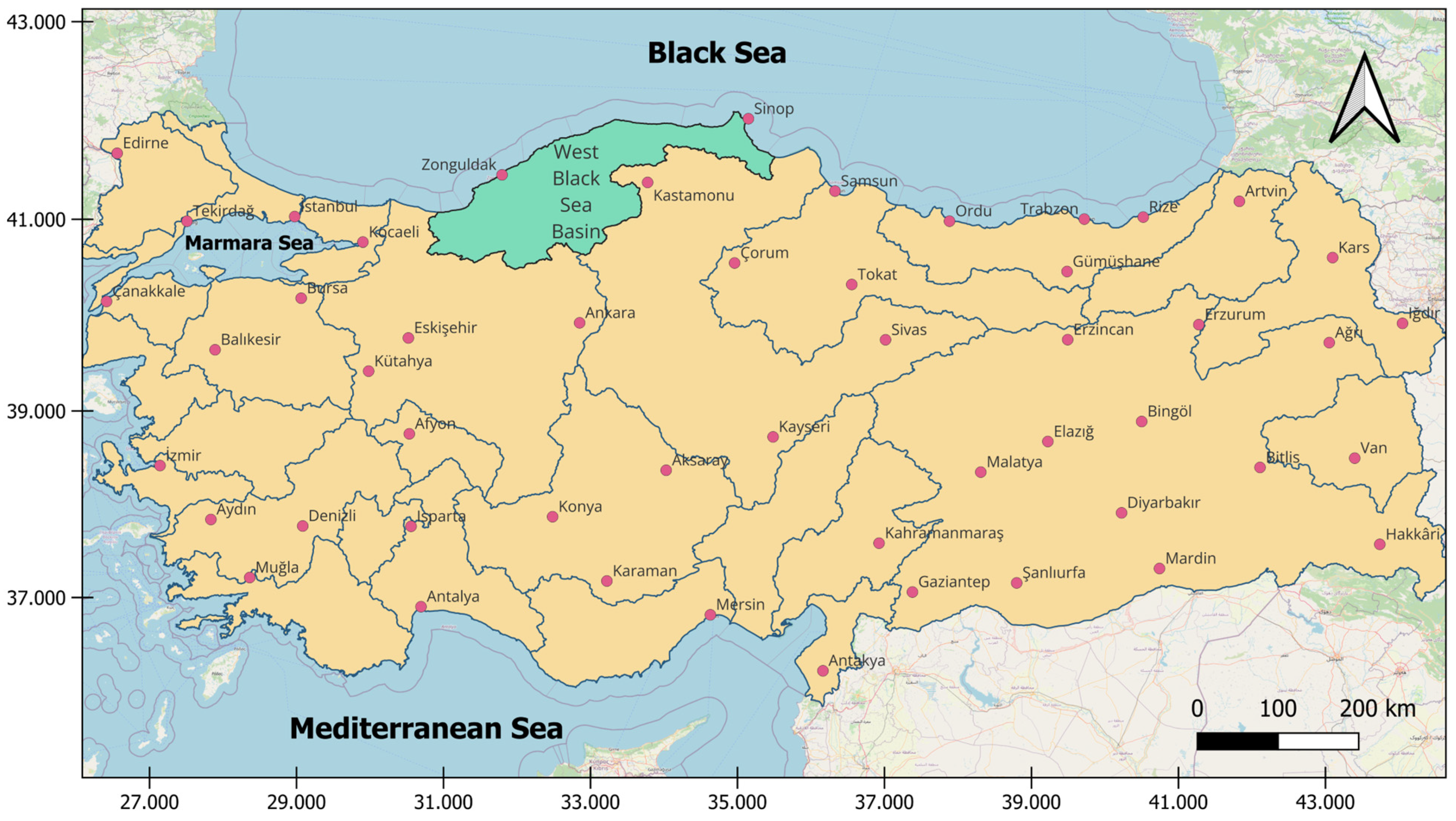
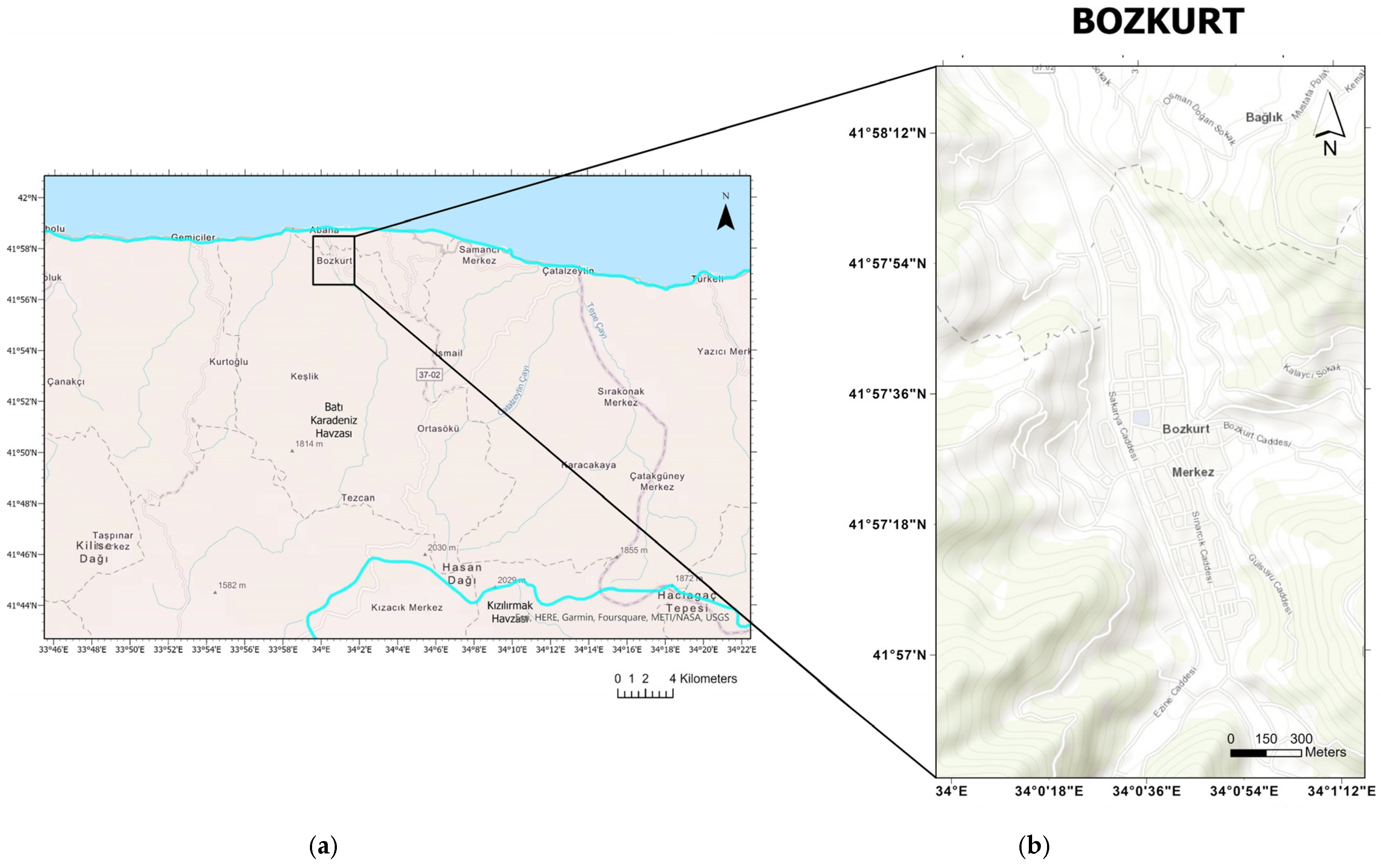
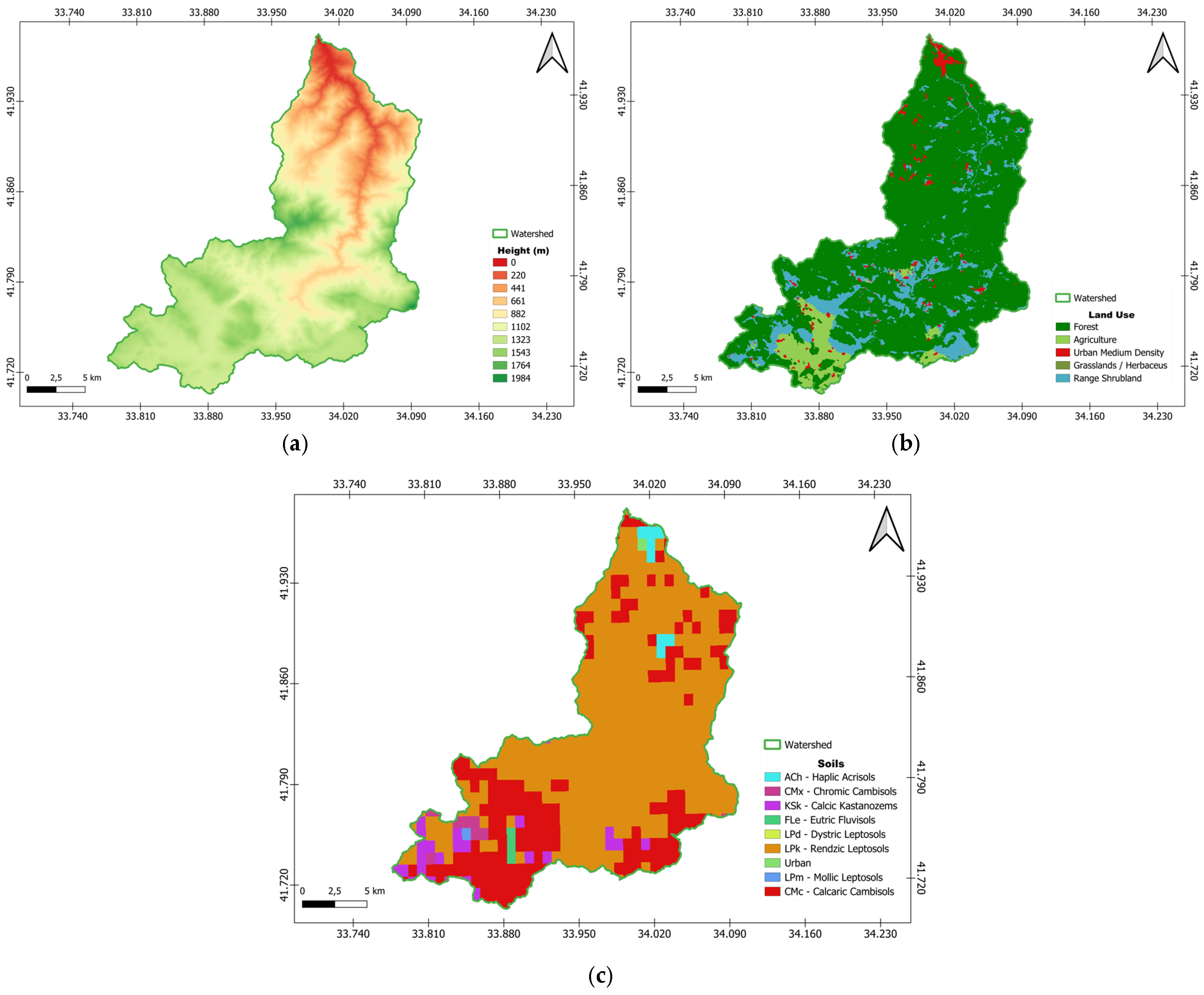

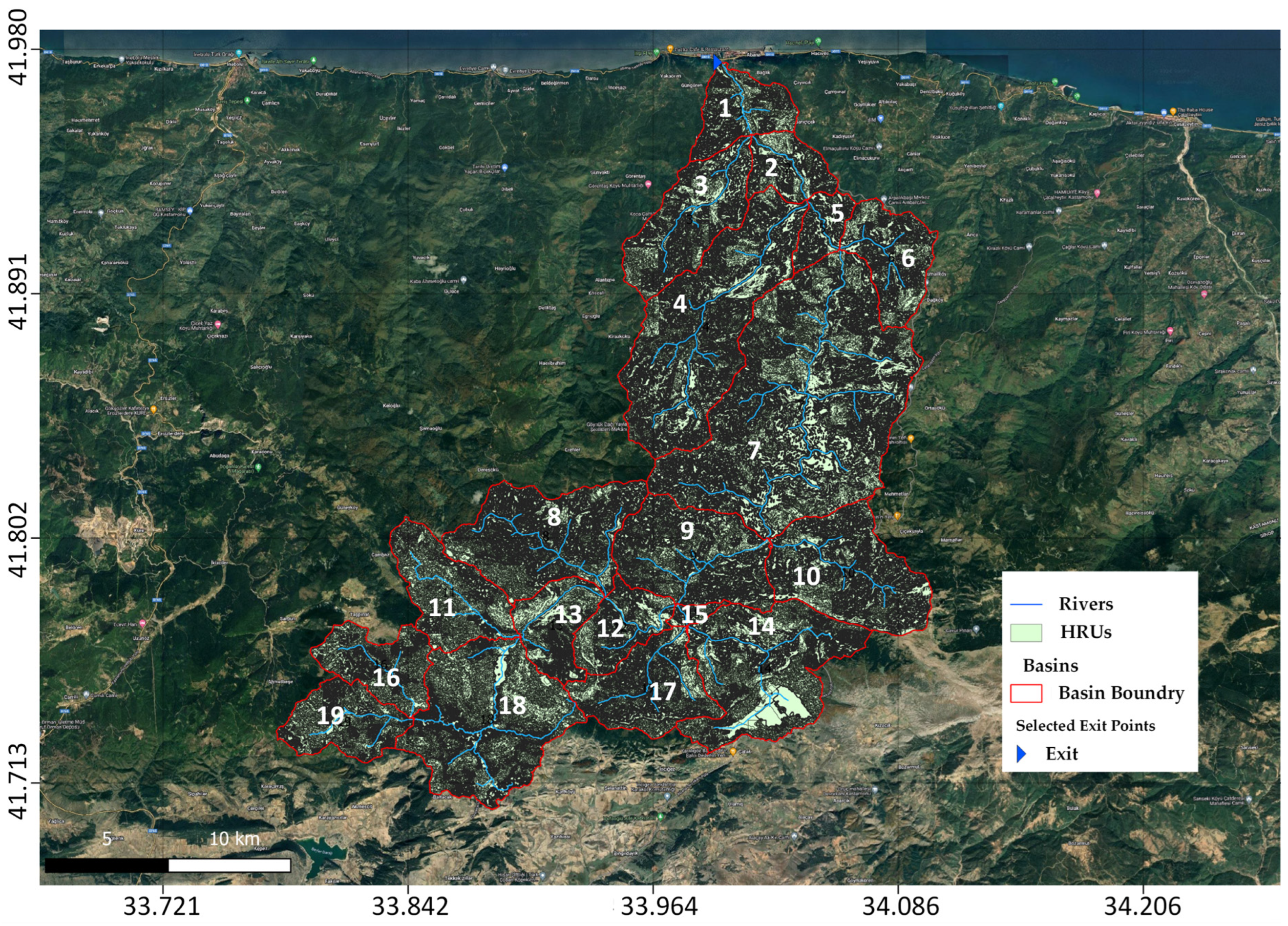
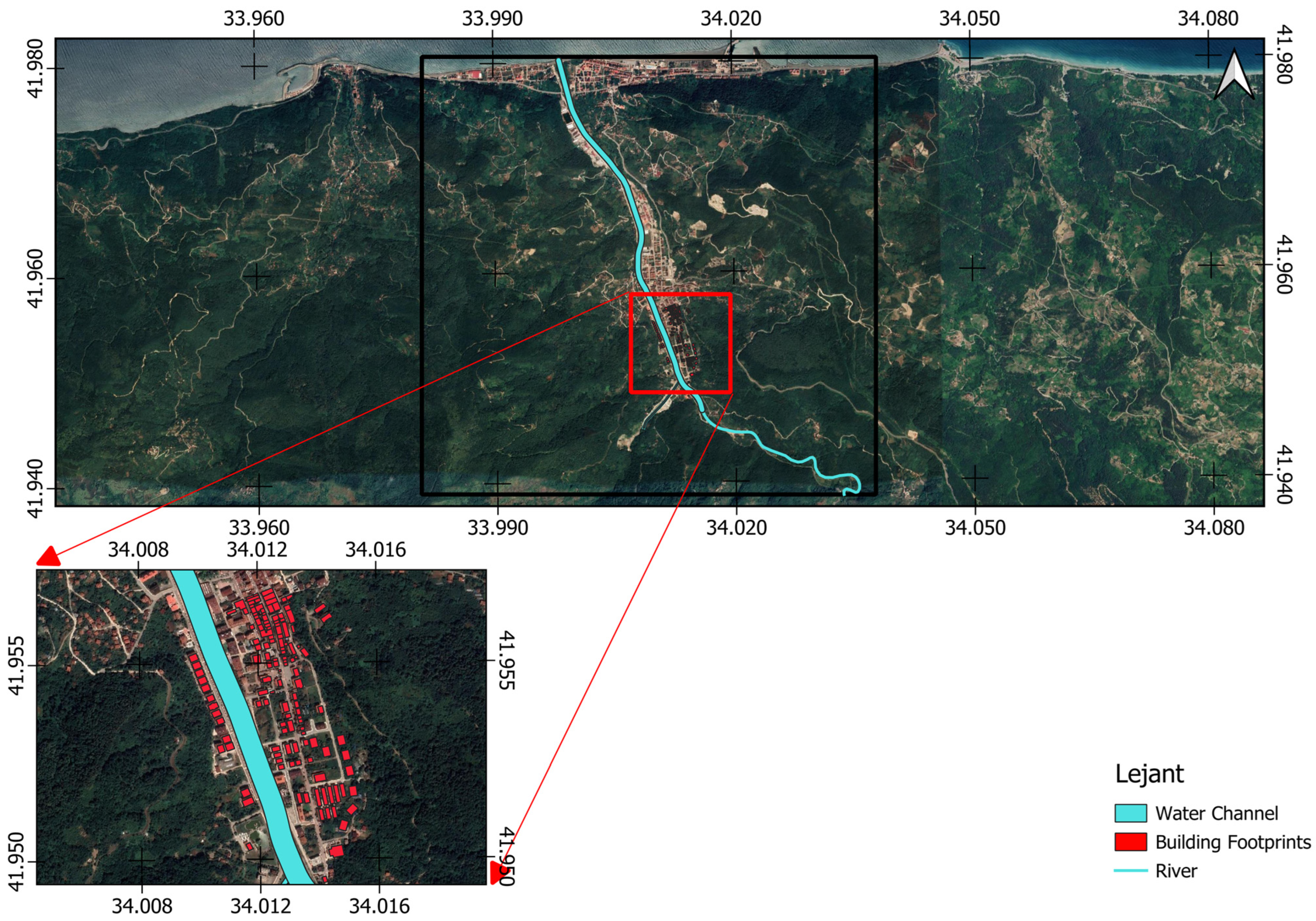
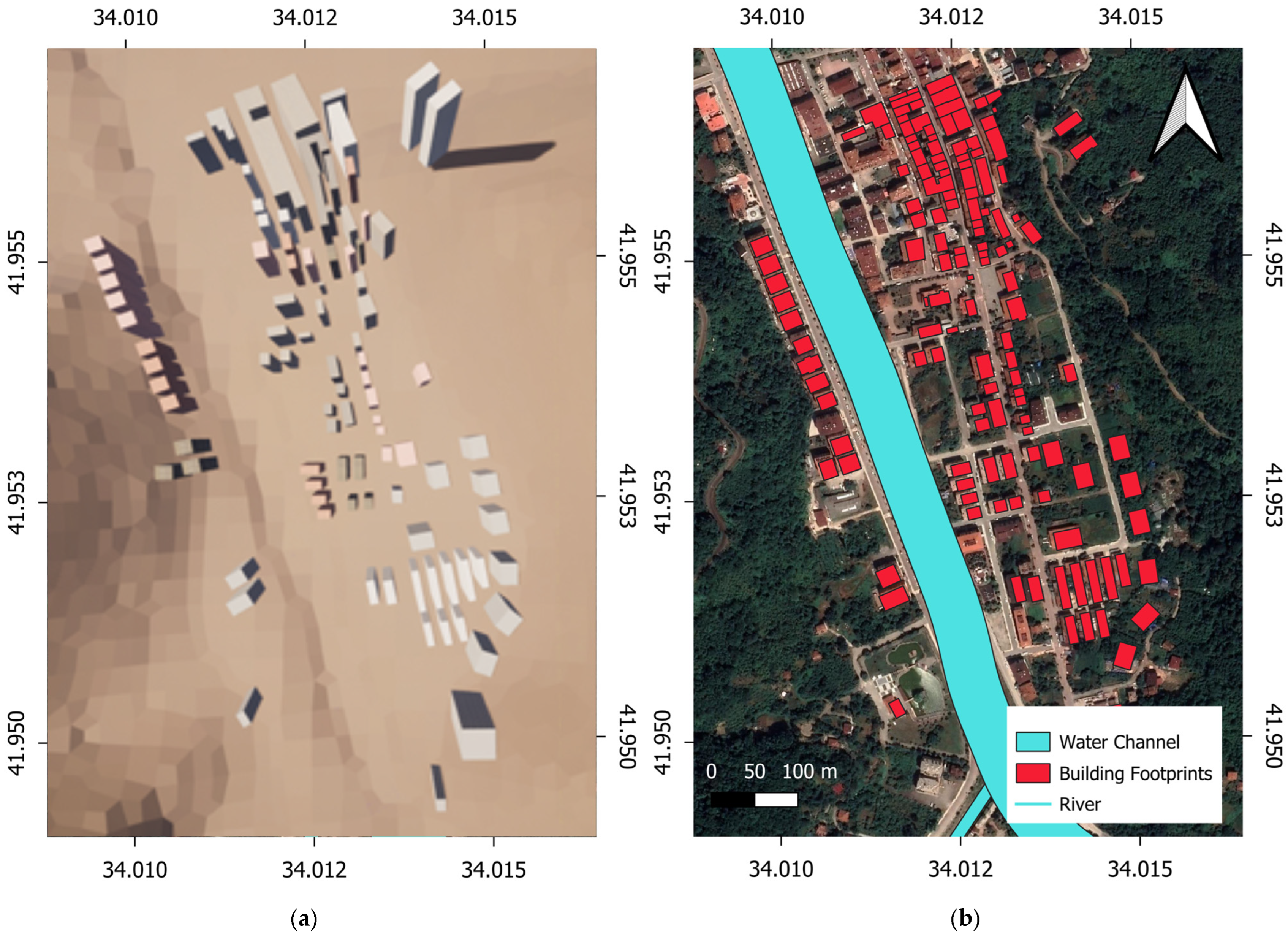

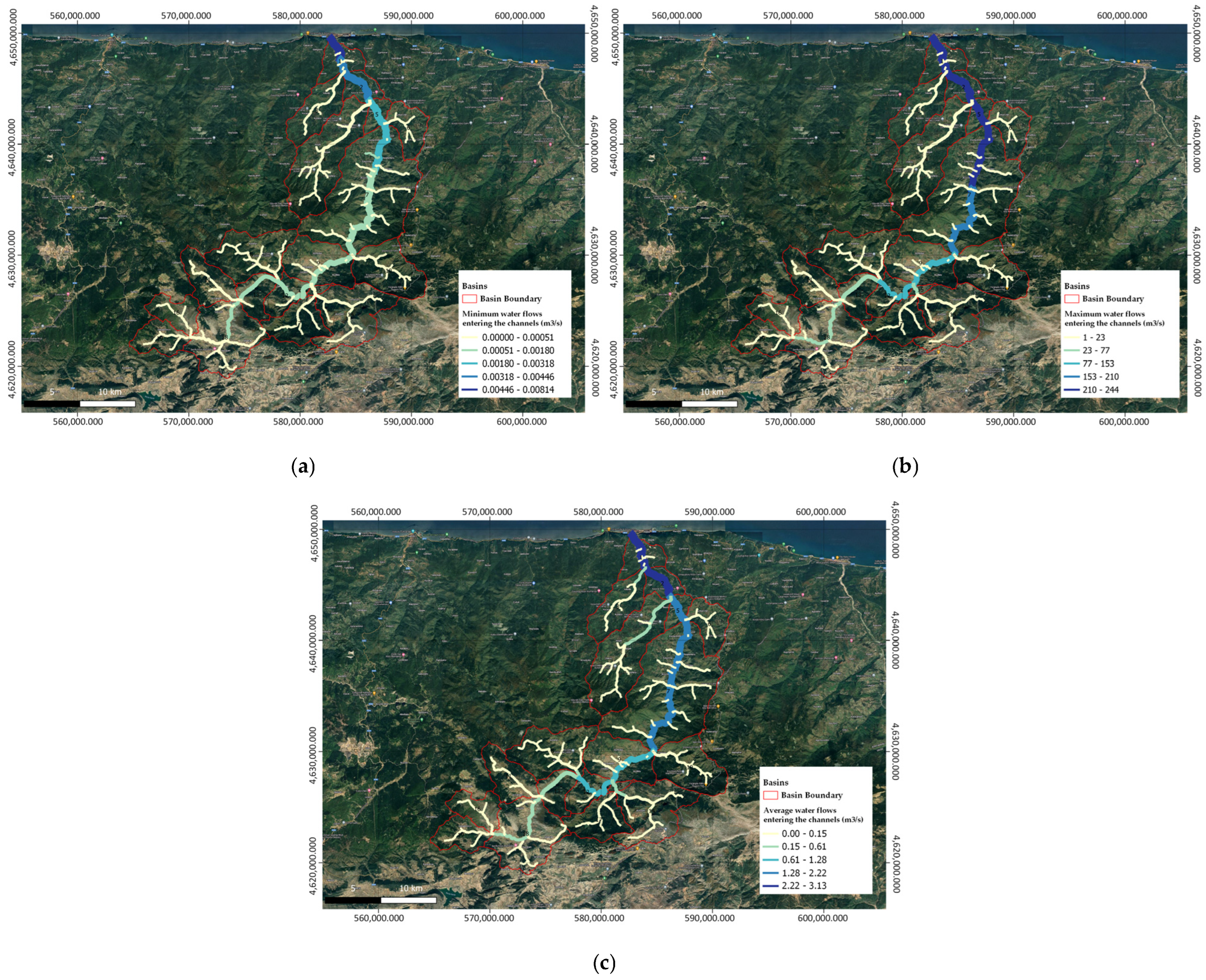
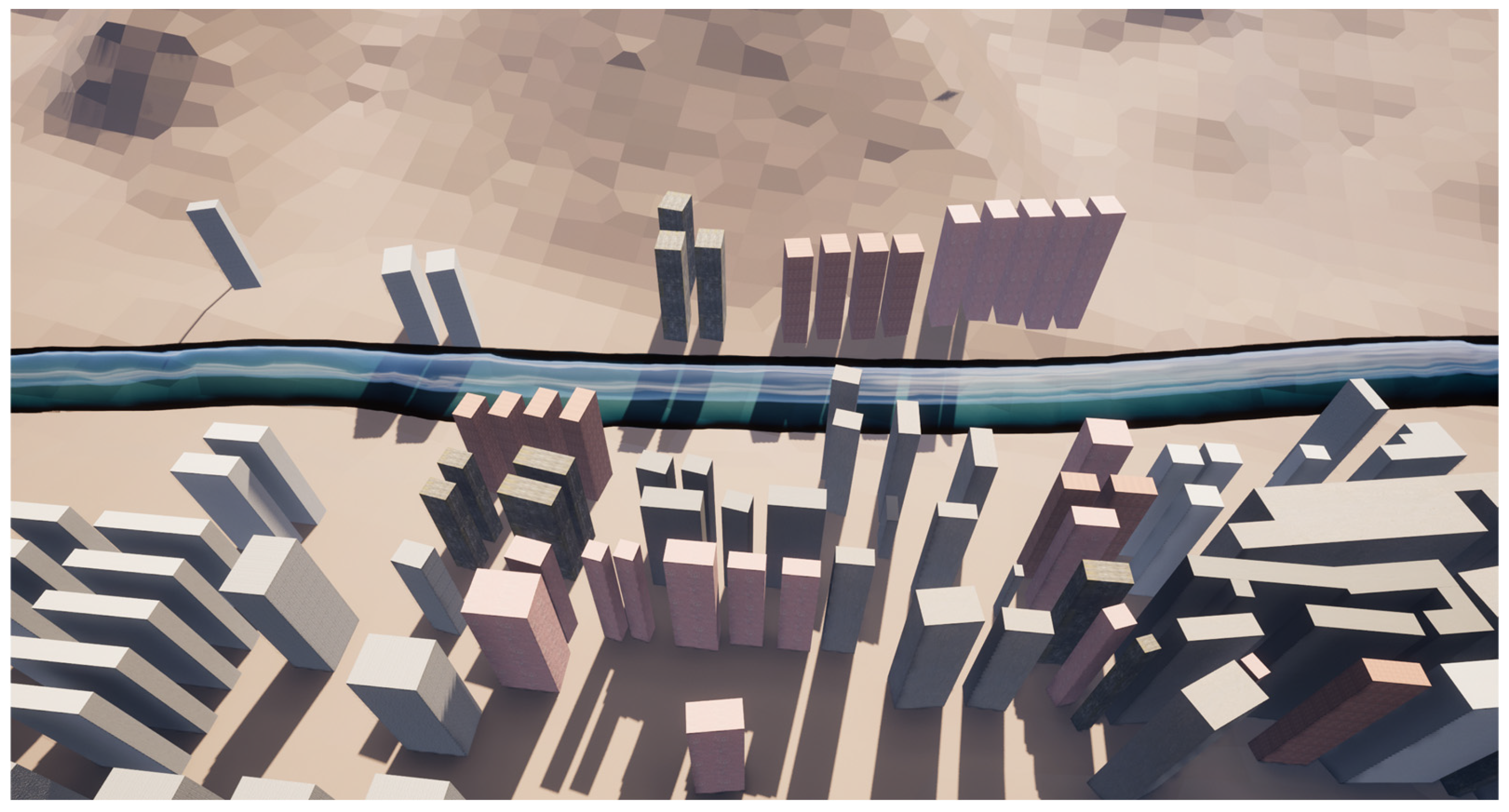
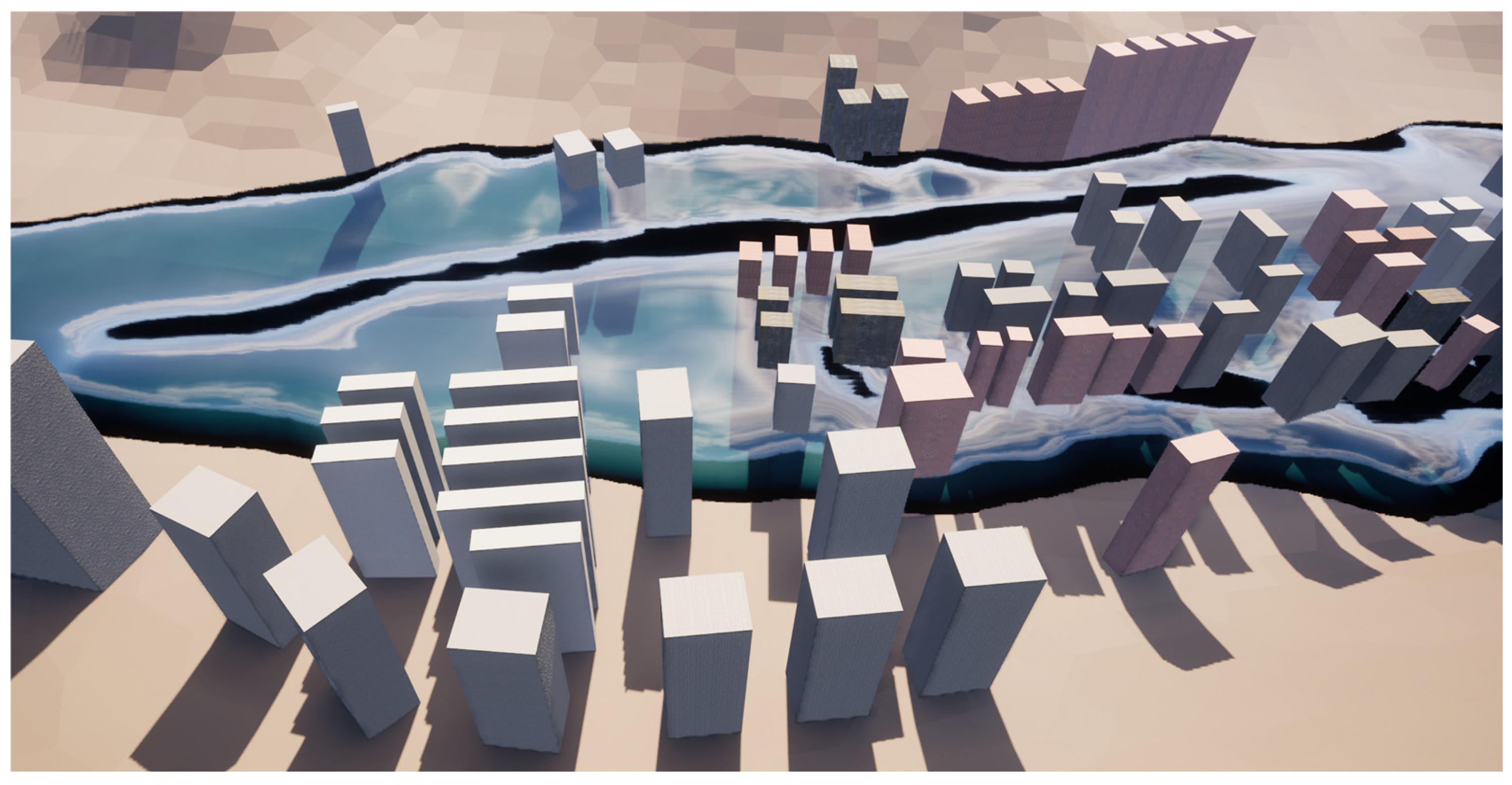

| Jan | Feb | Mar | Apr | May | Jun | July | Aug | Sep | Oct | Nov | Dec | Year | |
|---|---|---|---|---|---|---|---|---|---|---|---|---|---|
| Average Temperature (°C) | −0.6 | 1.1 | 4.8 | 9.5 | 14.2 | 17.7 | 20.5 | 20.5 | 16.2 | 11.2 | 4.9 | 0.7 | 10.1 |
| Average Maximum Temperature (°C) | 3.6 | 6.9 | 11.5 | 17.0 | 21.7 | 25.3 | 28.8 | 29.1 | 24.6 | 18.7 | 11.2 | 4.8 | 16.9 |
| Average Minimum Temperature (°C) | −3.8 | −3.1 | −0.4 | 3.4 | 7.7 | 11.0 | 13.0 | 13.1 | 9.5 | 5.9 | 0.5 | −2.4 | 4.5 |
| Average Sunshine Duration (hour) | 2.0 | 3.4 | 4.1 | 5.4 | 6.4 | 7.4 | 8.8 | 8.6 | 6.4 | 4.8 | 3.5 | 1.8 | 5.2 |
| Average Number of Rainy Days | 12.23 | 10.77 | 12.37 | 12.80 | 14.40 | 12.60 | 6.73 | 6.10 | 7.17 | 9.37 | 9.07 | 12.07 | 125.7 |
| Average Monthly Total Rainfall (mm) | 29.4 | 28.1 | 38.5 | 50.5 | 77.9 | 89.6 | 36.0 | 38.2 | 38.7 | 34.8 | 27.5 | 36.1 | 525.3 |
| Parameter | Explanation | Source | Data Type | Spatial Resolution/Scale |
|---|---|---|---|---|
| Amount of precipitation | Daily precipitation amount. | Turkish Meteorological General Directorate | Point | |
| Temperature | Average temperature data by season. | Turkish Meteorological General Directorate | Point | |
| Digital Elevation Model | Height information of the terrain. | NASA | Raster | 12.5 m |
| Building Heights and Models | Includes building heights and shapes. | OSM | Vector | |
| Land Use Land Cover Map | Land use and land cover data. | ESRI Land Cover | Raster | 10 m |
| Soil Properties | Soil types, hydraulic conductivity, water retention. | FAO | Raster | 1 km |
| Humidity | Average humidity data by season. | Turkish Meteorological General Directorate | Point |
| Parameter | Explanation |
|---|---|
| SOL_Z (Soil Depth) | Indicates the depth of each soil layer in millimetres. |
| SOL_BD (Soil Volume Weight) | Expresses the volume weight of each soil layer in grams/cm3. |
| SOL_AWC (Available Water Capacity): | Indicates the available water capacity (%) of each soil layer. |
| SOL_K (Saturated Hydraulic Conductivity): | Expresses the saturated hydraulic conductivity of each soil layer in mm/h. |
| SOL_CBN (Soil Organic Carbon Content): | Indicates the amount of organic carbon in each soil layer in %. |
| CLAY (Clay Content): | Indicates the clay content in each soil layer in %. |
| SILT (Silt Content): | Indicates the silt content in each soil layer in %. |
| SAND (Sand Content): | Indicates the sand content in each soil layer in %. |
| ROCK (Rock Content): | Indicates the rock content in each soil layer in %. |
| SOL_ALB (Soil Surface Albedo Value) | Indicates the reflectivity of the soil surface. |
| USLE_K (USLE Erosion Coefficient) | Specifies the soil erosion coefficient for the Universal Soil Loss Equation (USLE). |
| SOL_EC (Soil Electrical Conductivity) | Indicates the salinity of each soil layer in dS/m. |
| Parameter | Value |
|---|---|
| Sub-basin area | 98.59 km2 |
| Sub-basin perimeter length | 18.83 km |
| Total basin perimeter | 163.74 km |
| Stream length within the sub-basin | 3.15 km |
| Total basin area | 408.41 km2 |
| Total stream length | 220.80 km |
| UE Parameter | Symbol | Value | Unit | Explanation |
|---|---|---|---|---|
| Gravity | g | 9.81 (↓ Z) | m s−2 | defines the flow regime. |
| Particle Density | 0 | 1000 | kg m−3 | |
| Viscosity | ν | 1 × 10−6 | m2 s−1 | |
| Surface Tension | σ | 0.005 | N m−1 | descibes the small-scale wave behaviour. |
| Maximum Velocity | umax | 2.0 | m s−1 | ; stability is maintained by trimming very large speeds. |
| Minimum Velocity | umin | 0.01 | m s−1 | It decreases computational load by counting very low speeds as “0”. |
Disclaimer/Publisher’s Note: The statements, opinions and data contained in all publications are solely those of the individual author(s) and contributor(s) and not of MDPI and/or the editor(s). MDPI and/or the editor(s) disclaim responsibility for any injury to people or property resulting from any ideas, methods, instructions or products referred to in the content. |
© 2025 by the authors. Licensee MDPI, Basel, Switzerland. This article is an open access article distributed under the terms and conditions of the Creative Commons Attribution (CC BY) license (https://creativecommons.org/licenses/by/4.0/).
Share and Cite
Ozturk, A.; Atik, M.E.; Koşucu, M.M.; Atik, S.O. A Framework for 3D Flood Analysis Using an Open-Source Game Engine and Geospatial Data: A Case Study of the Bozkurt District of Kastamonu, Türkiye. Geomatics 2025, 5, 46. https://doi.org/10.3390/geomatics5030046
Ozturk A, Atik ME, Koşucu MM, Atik SO. A Framework for 3D Flood Analysis Using an Open-Source Game Engine and Geospatial Data: A Case Study of the Bozkurt District of Kastamonu, Türkiye. Geomatics. 2025; 5(3):46. https://doi.org/10.3390/geomatics5030046
Chicago/Turabian StyleOzturk, Abdulkadir, Muhammed Enes Atik, Mehmet Melih Koşucu, and Saziye Ozge Atik. 2025. "A Framework for 3D Flood Analysis Using an Open-Source Game Engine and Geospatial Data: A Case Study of the Bozkurt District of Kastamonu, Türkiye" Geomatics 5, no. 3: 46. https://doi.org/10.3390/geomatics5030046
APA StyleOzturk, A., Atik, M. E., Koşucu, M. M., & Atik, S. O. (2025). A Framework for 3D Flood Analysis Using an Open-Source Game Engine and Geospatial Data: A Case Study of the Bozkurt District of Kastamonu, Türkiye. Geomatics, 5(3), 46. https://doi.org/10.3390/geomatics5030046







